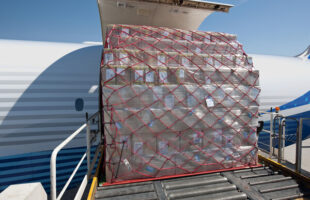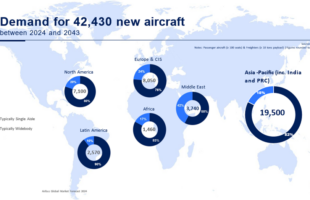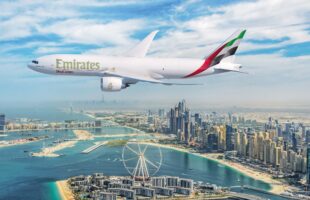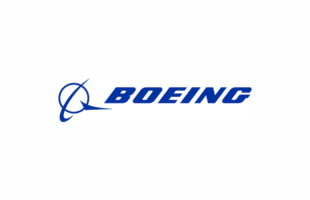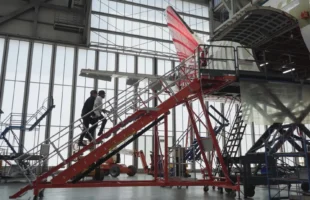
Even as global air freight volumes continue to rise and the express and retail market balloons, freighter operators have been zooming in on converted narrowbody aircraft. Sharang G reports on the booming P2F market.
The International Air Transport Association (IATA) released data for global air freight markets showed that demand, measured in freight tonne kilometers (FTKs), increased by 11.4 per cent in July 2017 compared to the same period a year ago: Fourth time in five months that double-digit annual growth was recorded. July’s year-on-year increase in demand was nearly four times higher than the ten year average growth rate of 3.1 per cent. With demand continuing to outstrip capacity, it seems certain that airline yields and the industry’s financial performance will be watched with interest.
The robust growth in air cargo demand was consistent with an uptick in global trade, rising export orders and upbeat business confidence indicators. But Alexandre de Juniac, IATA’s director general and CEO held out a word of caution: “July was a strong month for air cargo with double-digit growth. And for the third consecutive month demand for air freight grew at a faster pace than demand for air travel. While the outlook for the rest of the year remains positive, there are signs that the cyclical growth period may be nearing a peak.”
The caution apart, how are air cargo operators looking at the strong showing by cargo – possibly the strongest first half-year performance since air cargo’s rebound from the financial crisis in 2010? And, more importantly, what will the growth mean for those inducting capacity?

To begin with, the top plane manufacturers, Boeing and Airbus, have put out robust freighter figures for the next 20 years. In its Current Market Outlook 2017-2036, Boeing mentioned that the freighter market would require 2,480 additional freighters (1,560 conversions and 920 new) while Airbus has in its Global Market Forecast 2017-2036, pointed out that an additional 1,950 freighters (1,218 conversions and 732 new) will be needed in the world.

While old aircraft continue to be in demand – in fact, quite a few are available in the market – and operating them at the present low fuel prices remains feasible, air cargo operators have started looking out for new generation converted freighters to fulfil their long term plans.
The market for converted freighters has seen a steady growth over the past year or so. It was, perhaps, the move by Amazon to start its freighter services in the US that changed the environment for converted freighters. Almost a year ago, in May 2016, Amazon tied up with Atlas for 20 B767-300 converted freighters. Though all the aircraft were not available at one go, an Atlas spokesperson was quoted saying that the company had managed to get hold of the aircraft, as well as the conversion slots. So, it would move up from the present six aircraft in service for Amazon to 20 by the end of 2018.
Conversions cannot be performed overnight and with the ballooning growth of the e-tail sector, the demand for the 767s has been at its peak simply because the aircraft – after its reconfiguration – remains the best suited for express operations. To top it all, there are only a couple of outfits that can handle these P2F (passenger to freighter) conversions: Boeing and Israel Aerospace Industries being two of them. It goes without say, it is not only Boeing planes that are suited for conversion to freighters. From the Airbus stable, there are two planes that are doing well as converted freighters: the A330PTF and the A321PTF.
In fact, it is the narrowbody that has become popular for conversions. “Much of the good news on the freighter market today is coming from the narrowbody sector,” Robert V Dahl, managing director, ACMG, was quoted saying at the release of the 20-year Freighter Forecast for 2017-2036 at the sixth-annual Cargo Facts Asia conference in Shanghai in April. “ Will that continue? We are now in the fourth year of a narrowbody revolution, and with e-commerce continuing to fundamentally alter global retail consumption, narrowbodies will continue to be the big story in airfreight.” The ACMG forecast said that there would be 1,178 narrowbody freighters by 2036, and by then the aircraft will account for about 43 per cent of the total freighter fleet of 2,341 aircraft. “The robust activity in freighter conversion of narrowbody types over the past four years has led to an increase in the quantity of narrowbody freighters in the global fleet,” according to Dahl. This increase reversed a trend that began in 2000 through which the narrowbody freighter fleet decreased by about 40 per cent over a decade-long period. That clearly means that the B737-700s and 800s will make up the lion’s share in freighter fleets. The market for the 737-800BCF (Boeing Converted Freighter) has gone up consistently with most of the demand coming from Asian operators.
While conversion numbers differ with each industry specialist, it can safely be assumed that there would be around 400-odd conversions from passenger planes in the next ten years – and that would be for all sizes. This, despite the fact, that Boeing has predicted a demand for 1,560 converted freighters over the next 20 years.
In fact, the plane maker is going through the motions of rolling out its first 737-800BCF, with the first converted version set for re-delivery in the fourth quarter of 2017 to the customer. The plane maker has received 60 orders for its 737-800BCF from eight customers, 737-800BCF from eight customers, a number of which will be completed in China. Kurt Kraft, Boeing’s Vice President of Freighter Conversions was quoted saying that there was a “tremendous amount of demand right now” for the -800 airplane in China” – fuelled by the growing middle class.
The high demand for the narrowbody freighters recently prompted world leader in aviation leasing and financing, GE Capital Aviation Services (GECAS) to order the conversion of 30 Boeing 737-800s into freighters. GECAS had launched the 737-800 freighter programme with Aeronautical Engineers (AEI) in 2015 and Boeing in 2016. Since then GECAS provided each programme with a prototype aircraft for modification at separate conversion facilities in Miami and Shanghai. All the feedstock aircraft will come from GECASs’ existing portfolio and converted when the aircraft end their current passenger leases from 2018 onward. GECAS currently owns approximately 220 passenger 737-800s that are distributed across more than 25 countries. The Next-Generation 737-800 freighter will be equipped with CFM56-7B engines, carry up to 23.9 tonnes of cargo with 12 main deck positions over 2,000 nautical miles.
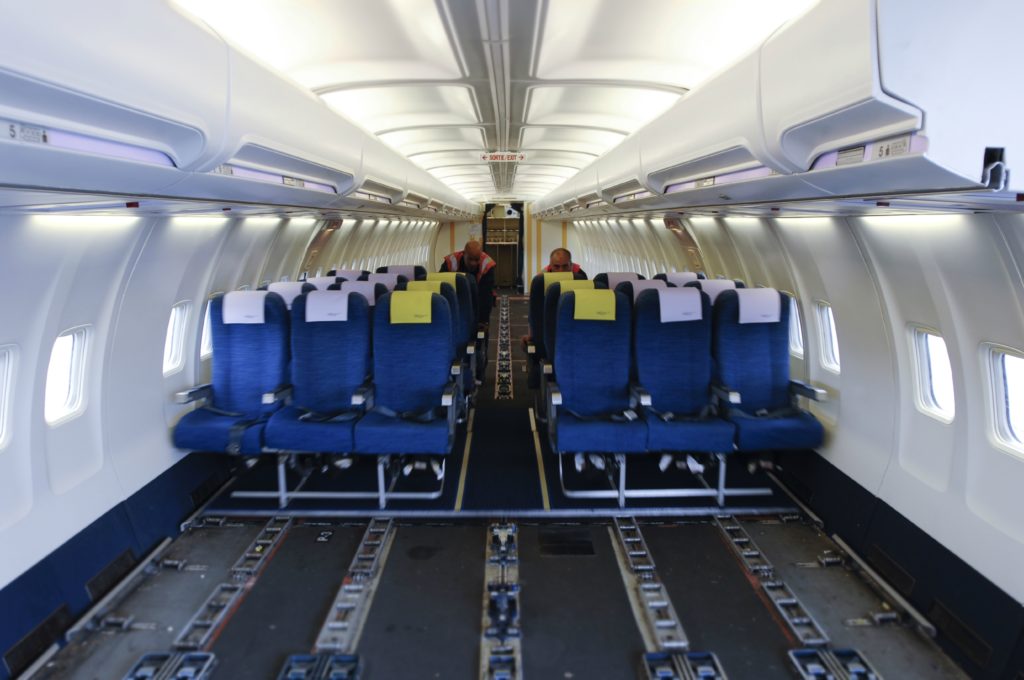
Bedek Aviation Group, a part of Israel Aerospace Industries, that recently opened a conversion centre for B767-300s in Mexico City, to be run by Mexicana MRO Services, signed a deal with China’s Haite Tianjin Aircraft Engineering to develop a conversion programme for Boeing 737NG passenger aircraft into freighters. Pointing out the narrowbody demand, Yosi Melamed, Bedek’s Executive Vice President and General Manager said in a press note that “the B737NG is the future ‘feedstock’ of the narrowbody freighters and we expect to be one of the first suppliers with an STC and a high-quality solution for the B737-800 that meets the growing market needs.”
First, however, a bit of history. When passenger planes “reach their age”, their lives are extended as freighters. The prime reason for their use is that a converted freighter is economical for operators compared to a newly produced freighter. The Passenger to Freighter (P2F) conversion programmes can be worked out by either the aircraft manufacturer or companies that have agreements with aircraft makers or companies that do the work independently. Soon after the Second World War, there were a number of used DC-3/C- 47, DC-4/C-54s that saw conversions to freighters.
The earliest conversions began with two types of planes: the B727-100 and B727-200 used as small and medium freighters and the DC-8 as larger freighters. Aircargopedia mentioned that “quite a number of 727s/DC-8s were successfully operated for more than 40 years”. It also mentions that “over the years, there were other P2F programmes, but none have come to the 727’s/ DC8’s figures. Some P2F programmes have reached significant numbers: B737-300/-400 (more than 220), B-757-200 (more than 190), MD-11 (121), DC-10 (106).”
The demand for the B737-800s as freighters will grow from 2020. According a recent white paper released by UK-based consultancy IBA Group, the B737-800s that were in their mid-lives would find takers for conversion. The consultancy group pointed out that in the next 2 – 3 year period, these new generation B737-800s would become the mainstay of cargo operators, since there would be quite a few in the age groups of between 14 and 19 years – the ideal age for a makeover to freighters.
According to IBA Group, the estimated market value for a 737-800 as a conversion candidate is $11 million or less, that would be a beneficial return on investment criteria though the present market value varies from $12.5 million for a 19-year-old to $19.1 million for a 14-year-old. The forecast in the white paper mentions that the conversion-suitable 737-800s “at the $11 million price point will become more available in 24 to 36 months, with an acceleration for replacement and growth from 2020 onwards”. The major factors for that price would depend on the maintenance status and the condition of the engines. IBA also pointed out that from the end of next year, after supplemental type certificates become available for the 737-800 conversions by the four companies that have announced their plans for conversions – Boeing, Aeronautical Engineers, IAI and Pemco — the airplanes costing $11 million or less will be ideally placed for conversion. These planes will have lower monthly lease rates, according to the forecast.
Demand from the express services will continue to dictate the growth of the P2F sector. And Asian operators would be at the top of the conversions list. A recent report quoted PEMCO’s Director of Conversion Programmes, Mike Andrews saying that though he could not reveal the exact number of orders at PEMCO, there was a backlog. The market in China was huge: PEMCO had converted around 70 per cent of all B737-300/400 flying in the country.

On the other hand, there were quite a few Airbus’ A330-200s and A330-300s flying around that would, according to industry experts, provide the feedstock for P2F conversions. Incidentally, of the 2,700-odd freighters that would be seen in the next two decades, half of them would be in the mid-size A330 group. The longer-fuselage A330-300P2F is popular with integrators and express operators because of its high payload capability with lower-density cargo. The A330-200P2F is suited for higher-density freight and longer-range performance.
The A330P2F conversion is done through a partnership between ST Aerospace of Singapore the EADS EFW sister company in the Airbus Group and Airbus; where the former will obtain another 20% of EFW shares and provides a specially developed conversion technology. ST Aerospace will thus increase its stake in EFW to 55%, with Airbus Group becoming a minority partner in EFW, reducing its shareholding to 45%.
In the small freighter segment, Airbus foresees a significant market demand of more than 600 aircrafts over the next 20 years for P2F aircraft conversions. The A320P2F will be capable of carrying 21 metric tonnes of payload over 2,100 nautical miles, while the A321P2F will be able to carry up to 27 tonnes over 1,900 nautical miles. The first converted A321P2F will be delivered in 2018, and will be marketed and managed by EFW.
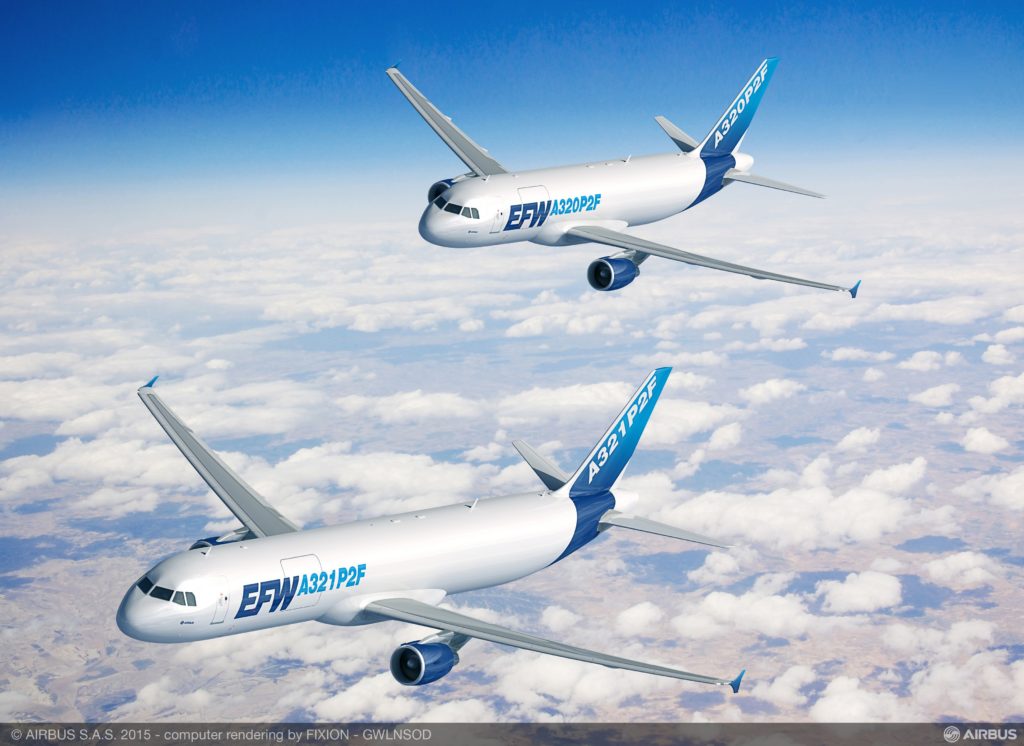
There’s time – even for P2F conversions
The iconic B747 has virtually done its curtain call. But there was a time when the ‘Jumbo’ held sway. Hailed as a top-seller in the Boeing 747 family, the 747-400 had a number of technological and structural improvement that made it more efficient than others. No wonder aviation pundits pointed out that a converted freighter version would prove to be a bigger revenue earner than the 747-200 freighters.
In 2008, the environment was just not right for the B747-400. The economy was in a spin, fuel prices were high and the market was bad. Add to that the fact that there were the more efficient B777 and the 747-8 freighters. Reports indicate that 79 747-400s were converted but the demand went down to zero in 2012. That saw an end to the 747-400 P2F programme. It was timing that sent the B747-8 programme crashing.
Unlike the B747-8, Airbus’ A300B4 was a success as a converted freighter. The concept of a short haul widebody was flawed – though the aircraft will be remembered as Air France Flight 139 from Tel Aviv to Paris, that was the focal point of the famous Entebbe hijack — and a number of carriers operating the A300 were forced to reduce frequencies to try and fill the aircraft. Result: they lost passengers to airlines operating more frequent narrowbody flights.
However, largely due to the timing, as a converted freighter it did well since similar size planes were not available. Altogether, 74 A300B4s were converted in P2F programmes (between 1987and 2000) and flew as freighters for quite a number of years, according to reports in aircargopedia.com.
There is another aircraft that virtually resurrected itself: the B767. Boeing’s first wide-body twinjet it had to make way for the faster and more efficient B777s. However, as freighters, they have done well. At the recent Paris Air Show, UPS announced plans to convert three 767 passenger airplanes into Boeing Converted Freighters. “The purchase and conversion of these 767s is a perfect example of how UPS is making smart investments to fuel profitable growth,” said UPS Airlines President Brendan Canavan. “This extension of our relationship with Boeing will help expand the safe, reliable and on-time services we provide for our customers all over the world.”
“It’s a privilege for us to supply and support UPS with Boeing Converted Freighters,” said Stan Deal, President and CEO, Boeing Global Services. “With more than 40 years of experience in passenger-to-freighter conversions, Boeing has a deep understanding of the needs of the air cargo industry. This order is an endorsement of the value of that knowledge and the customer service experience we provide.”



